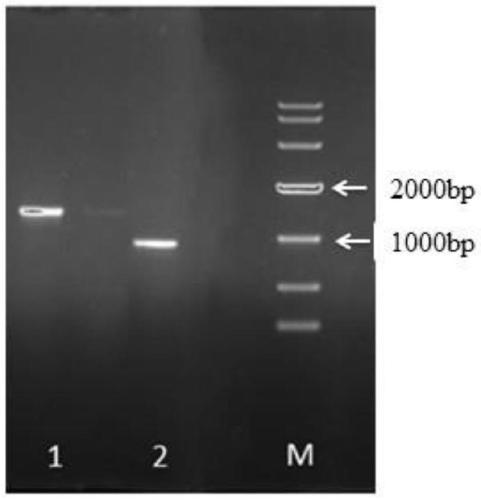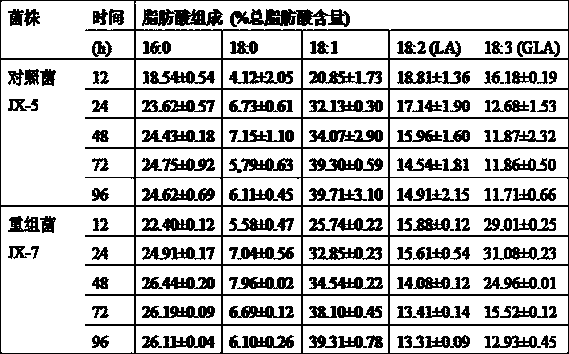Construction method and application of engineered strain of mucor circinelloides using cellulose to efficiently synthesize gamma-linolenic acid
A technology of Mucor cuspidatum and engineering strain, which is applied in the fields of genetic engineering and biology, and can solve the problems of low content and high production cost of γ-linolenic acid
- Summary
- Abstract
- Description
- Claims
- Application Information
AI Technical Summary
Problems solved by technology
Method used
Image
Examples
Embodiment 1
[0011] Example 1: This example illustrates the cloning process of Δ6 fatty acid desaturase and cellulase genes and the construction of recombinant plasmids.
[0012] According to The codon preference of Mucor crimperida, a fusion gene (3003 bp) synthesized by General Biosystems (Anhui) Co., Ltd. According to the principle of homologous recombination, the fusion gene and marker gene pyrF The gene was ligated into an overexpressed fragment by fusion PCR, and the recovered fragment was ligated with the plasmid pMAT2075 (built by the laboratory) vector, and the ligated product was transformed into Escherichia coli Top10 competent cells, and the transformed product was coated on an LB plate (peptone 10 g / L, yeast extract 5 g / L, NaCl 10 g / L, agar 1.5 %). After culturing overnight at 37°C, colonies were selected and inserted into LB liquid medium (peptone 10 g / L, yeast extract 5 g / L, NaCl 10 g / L), and after 8-10 h, the plasmid was extracted for sequence determination, and the sequ...
Embodiment 2
[0013] Example 2: This example illustrates the restriction enzyme digestion and transformation of the recombinant plasmid CRC-29 with the desired fragment.
[0014] The recombinant plasmid CRC-29 preserved above was streaked on LB solid medium colonies, and single colonies were picked and cultured in LB medium (peptone 10 g / L, yeast extract 5 g / L, NaCl 10 g / L) for 12 -16 hours, extract the plasmid with a plasmid kit; add the plasmid to Acll and SmaI enzymes in sequence, first digest at 37 °C for 1 h, and then digest at 25 °C overnight to obtain the target gene fragment required for transformation. NanoDrop2000 assay.
Embodiment 3
[0015] Example 3: This example illustrates the transformation process of Mucor circiniferii.
[0016] (1) Protoplast preparation
[0017] Inoculate the spores of Mucor circiniferatum M65 strain (uracil-deficient strain) into YPG medium (yeast extract 3 g / L, peptone 10 g / L, glucose 20 g / L, uracil 200 µg / mL, pH 4.5 ) plate, cultured at 28°C for 1 day. Take the monoclonal hyphae and plant them on the plate of YPG medium, and culture them at 28°C for 3-4 days, and the spores will grow well. Take a plate with good spore growth, add 5-6 mL of YPG medium to each plate, scrape the spores with a sterilized spreader stick, collect the spore suspension in a sterilized 50 mL centrifuge tube, and use a hemocytometer Calculate the concentration and adjust the number of spores to 12.5×10 with YPG at pH 4.5 7 indivual. Take the above spore suspension into a sterilized 250 mL Erlenmeyer flask and place it in a refrigerator at 4 °C overnight to allow the spores to fully absorb water and swe...
PUM
 Login to View More
Login to View More Abstract
Description
Claims
Application Information
 Login to View More
Login to View More - R&D
- Intellectual Property
- Life Sciences
- Materials
- Tech Scout
- Unparalleled Data Quality
- Higher Quality Content
- 60% Fewer Hallucinations
Browse by: Latest US Patents, China's latest patents, Technical Efficacy Thesaurus, Application Domain, Technology Topic, Popular Technical Reports.
© 2025 PatSnap. All rights reserved.Legal|Privacy policy|Modern Slavery Act Transparency Statement|Sitemap|About US| Contact US: help@patsnap.com



